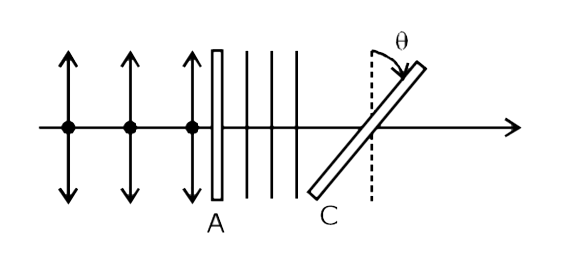Two crossed polarod A and B are placed in the path of a beam of unpolarized light . In between these two polaroid, a third polaroid C is placed such that its principal section is at an angle of with that of A. What percentage of intensity of incident unpolarized light emerges from C and B ?
Let be the intensity of unpolarized light on polaroid A
Polaroids A and B are in crossed position
Angle between A and C=

Light transmitted by
will be the intensity of light incident on B. Angle between A and B= and the angle between A and C =
Angle between C and B
Light transmitted by B=9.38%
Result: Intensity of light transmitted by
Intensity of light transmitted by
Similar Questions
Two 'crossed' polaroids A and B are placed in the path of a light-beam. In between these, a third polaroid is C is placed whose polarisation axis makes an angel θ with a polarisation axis of the polaroid A. If the intensity of light emerging from the poloaroid a is Io then show that the intensity of light emerging from polaroid B will be 14Iosin2θ.
View SolutionTwo polaroids are oriented with their planes perpendicular to incident light and transmission axis making an angle of 30∘ with each other. What fraction of incident unpolarised light transmitted?
View Solution
Knowledge Check
- Question 1 - Select One
Two 'crossed' polaroids A and B are placed in the path of a light-beam. In between these, a third polaroid is C is placed whose polarisation axis makes an angle θ with a polarisation axis of the polaroid A. If the intensity of light emerging from the polaroid a is Io then show that the intensity of light emerging from polaroid B will be 14Iosin2θ.
AI04sin22ϕBI04sin2ϕCI04cos2ϕDI02cos22ϕ - Question 2 - Select One
Two polaroids are oriented with their principal planes making an angle of 60∘. The percentage of incident unpolarised light, which passes through the system is
A1B0.5C0.25D12.5% - Question 3 - Select One
A beam of unpolarised light of intensity I0 is passed through a polaroidA and then through another polaroid B which is oriented so that its principal plane makes an angle of 45∘ relative to that of A. The intensity of the emergent light is
AI0BI02CI04DI08
At what angle should the axes of two polaroids be placed so as to reduce the intensity of incident unpolarized light to 1/3.
View Solution(a) Using the phenomenon of polarisation, show how transverse nature of light can be demonstrated.
(b) Two polaroids P1andP2 are placed with their pass axes perpendicular to each other. Unpolarised light of intesity I0 is incident on P1. A third polaroid P3 is kept in between P1 and P2 such that its pass axis makes an angle of 30∘ with that of P1. Determine the intensity of light transmitted through P1,P2andP3.View Solution(a) Using the phenomenon of polarization, show, how, transverse nature of light can be demonstrated.
(b) Two polaroids P1andP2 are placed with their pass axes perpendicular to each other. Unpolarised light of intensity 10 is incident on P1. A third polaroid P3 is kept in between P1andP2 such that its pass axis makes an angle of 30∘ with that of P1. Determine the intensity transmitted through P1,P2andP3.View SolutionTwo polrizers are oriented with transmission planes making an angle of 60∘. The percentage of incident unpolarized light that passes through the system is
View SolutionTwo polaroids are placed in the path of unpolarized beam of intensity I0 such that no light is emitted from the second polaroid. If a third polaroid whose polarization axis makes an angle θ with the polarization axis of first polaroid, is placed between these polaroids, then the intensity of light emerging from the last polaroid will be :
View Solution

